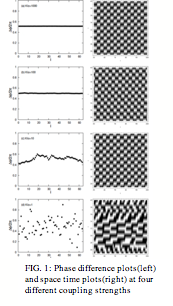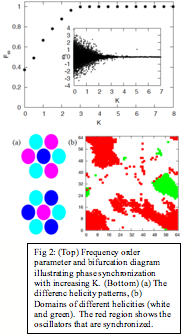AmericanChemicalSociety.com
Reports: ND6 49010-ND6: Pattern Formation in Spatially Structured Active Media: Theory and Simulations
Bulbul Chakraborty, PhD, Brandeis University
This New Direction grant launched my research on spatially structured, excitable chemical media. We have achieved a number of new results on the behavior of repulsively coupled chemical oscillators, and made significant progress in developing a framework for stochastic differential equations that model reaction-diffusion systems. The coupled oscillator work is being submitted to Physical Review E [cond-mat/arXiv:1009.6004].
FIG. 1: Phase difference plots(left) and space time plots(right) at four different coupling strengths Brief Summary of Results: In 1D, we have shown
using linear stability analysis as well as numerical results, that the stable
phase patterns depend on the geometry of the lattice. We also show that a
transition to the ordered state does not exist in the thermodynamic limit. In
two dimensions, we have shown that the geometry of the lattice constraints the
phase difference between two neighbouring oscillators to 2p/3, and that domains of opposite helicities
(Fig. 2) get frozen in as the frequencies synchronize. Michael Giver and Zahera Jabeen have
been the researchers primarily responsible for this project. Mitch Mailman helped design the project
in its initial stages, and Dapeng Bi is working on the model with amplitude
variations. We have studied
the coupled oscillator system using tools that are more commonly used in condensed
matter physics in the context of phase transitions. These tools have proven to be really beneficial in
understanding the emergence of phase and frequency coherence in these coupled
oscillators. We will continue to
push these techniques in analyzing more complicated models of coupled
oscillator systems. Patterns on 1D ring: When the coupling between the oscillators is turned off,
each of the oscillators in the system will evolve in time according to its own
frequency, wi. As we switch on and increase the
coupling, we observe the oscillators to form local frequency entrained
clusters. As the coupling is increased further, the clusters merge with one
another until eventually, at some critical value of the coupling constant, all
of the oscillators are entrained with a common frequency. Fig. 1 gives a qualitative picture of
the synchronization (or desynchronization) process in a system of 64
oscillators. The figure shows four space-time plots over a range of effective
coupling constants (K/s) and a
corresponding plot of the phase difference as a function of position on the
lattice. At low coupling both the frequencies and phases are disordered. As the
coupling is increased to K/s = 10, we
can see that all the oscillators evolve with approximately the same frequency,
but maintain some disorder in the phase relationships. It is not until a
coupling strength two orders of magnitude larger that we see perfect phase
ordering at this system size.
The experimental microdrop setup shows a pattern very similar to the
fully synchronized (antiphase) pattern. We have studied frequency and phase
synchronization, quantitatively by measuring appropriate order parameters. Fig 2: (Top) Frequency order parameter and bifurcation diagram illustrating phase synchronization with increasing K. (Bottom) (a) The differenc helicity patterns, (b) Domains of different helicities (white and green). The red region shows the oscillators that are synchronized. Lattice Models of Reaction-Diffusion Systems Theoretical studies of chemical oscillations broadly
fall into two categories: (1) a rate equation approach in which the reactants
are assumed to be well mixed, and (2) a partial differential equation approach
in which spatial dependence is taken into account by adding diffusion terms to
the rate equations. These two approaches explain qualitatively the experimental
phenomena. But it is well known that for reaction diffusion systems, often just
adding a diffusive term to the rate equations does not give the correct
quantitative answers, especially in low enough dimensions [U. C. Tuber, M.
Howard, and B. P. Vollmayr-Lee, J. Phys. A 38, R79 (2005]. There are usually
additional multiplicative noise terms arising due to intrinsic number
fluctuations in the system. This will be especially relevant for the micro
droplet experiments where there is finite probability for low concentration of
reactants. Michael Giver visited India and worked with Rajesh Ravindran to
implement a Gillespie algorithm for simulating reaction diffusion systems on a
lattice, and to begin the process of applying field theoretical techniques to
construct coarse-grained equations and correlation functions from these lattice
models.
 Coupled Chemical Oscillators: This theoretical/simulation study was directly motivated
by experiments performed by Irv Epstein (Co-PI) and Seth Fraden. The experiments studied arrays of
microdrops containing the reactants for the BZ (Belousov-Zhabotinsky)
reaction. The coupling between the
droplets, through the diffusion of the inhibitor, led to a multitude of
interesting patterns [[J. Phys. Chem. Lett. 1, 1241-1246 (2010)]]. We started with a minimal model to see how much
of the pattern formation could be understood from the geometrical frustration
that arises in oscillators that would like to be p
out of phase but are placed on a lattice on which that pattern cannot be
achieved globally, for example, on a hexagonal array. We numerically solved the
differential equations arising from phase oscillators with random (Gaussian-distributed)
frequencies, coupled repulsively through
nearest neighbor interactions on a 1D chain, 1D ring, and on a 2D hexagonal
array.
Coupled Chemical Oscillators: This theoretical/simulation study was directly motivated
by experiments performed by Irv Epstein (Co-PI) and Seth Fraden. The experiments studied arrays of
microdrops containing the reactants for the BZ (Belousov-Zhabotinsky)
reaction. The coupling between the
droplets, through the diffusion of the inhibitor, led to a multitude of
interesting patterns [[J. Phys. Chem. Lett. 1, 1241-1246 (2010)]]. We started with a minimal model to see how much
of the pattern formation could be understood from the geometrical frustration
that arises in oscillators that would like to be p
out of phase but are placed on a lattice on which that pattern cannot be
achieved globally, for example, on a hexagonal array. We numerically solved the
differential equations arising from phase oscillators with random (Gaussian-distributed)
frequencies, coupled repulsively through
nearest neighbor interactions on a 1D chain, 1D ring, and on a 2D hexagonal
array.
 Patterns
on a Triangular Lattice: On a
triangular lattice, the optimal local pattern of nearest-neighbor oscillators
locking into a p phase difference is
incompatible with the geometry.
Results from our numerical simulations show that the frequencies
synchronize beyond a critical coupling strength (for a finite size system),
however the phase pattern remains disordered with domains of different
helicities frozen in. The steady
state is, therefore, one where the whole array oscillates with the same
frequency but with no long-range order in the phase pattern. This is a glassy state with features
that are similar to disordered statistical systems such as spin glasses. We [Dapeng Bi, Zahera Jabeen, and
Bulbul Chakraborty] are in the process of studying extensions of our model that
allow amplitude fluctuations in order to see if that relieves the frustration
and leads to an ordered phase pattern.
Patterns
on a Triangular Lattice: On a
triangular lattice, the optimal local pattern of nearest-neighbor oscillators
locking into a p phase difference is
incompatible with the geometry.
Results from our numerical simulations show that the frequencies
synchronize beyond a critical coupling strength (for a finite size system),
however the phase pattern remains disordered with domains of different
helicities frozen in. The steady
state is, therefore, one where the whole array oscillates with the same
frequency but with no long-range order in the phase pattern. This is a glassy state with features
that are similar to disordered statistical systems such as spin glasses. We [Dapeng Bi, Zahera Jabeen, and
Bulbul Chakraborty] are in the process of studying extensions of our model that
allow amplitude fluctuations in order to see if that relieves the frustration
and leads to an ordered phase pattern.
Copyright © American Chemical Society

